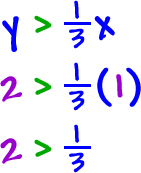This one's a little harder:
| Graph |
 |
* Remember -- to graph this guy use y = mx + b. And we'll use a dashed line since there is no =.
 |
What side do we shade?
The only glitch on this one is
that we can't try
|
|
Let's try
( 1 , 2 )
:
|
 |
Yep! It works! So, shade that side:
 |
All the
( x , y )
points in the shaded region work in
|
YOUR TURN:
|
Graph |
|

